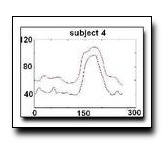
We present a robust three-dimensional parts-based
(PB) tracking system designed to follow the upper limb of
stroke survivors during desktop activities. This system fits a
probabilistic model of the arm to sequences of images taken
from multiple angles. The arm model defines shapes and colors
of limbs and limb configurations that are more or less likely.
We demonstrate that the system is 1) robust to cluttered scenes
and temporary occlusions; 2) accurate relative to a commercial
motion capture device; and 3) capable of capturing kinematics
that correlate with concurrent measures of post stroke limb
function. To evaluate the PB system, the functional motion of
7 stroke survivors was measured concurrently with the PB
system and a commercial motion capture system. In addition,
functional motion was assessed by an expert using the Fugl-
Meyer Assessment (FMA) and related to recorded kinematics.
Standard deviation of differences in measured elbow angles
between systems was 5.7 degrees; deviation in hand velocity
estimates was 2.6 cm/s. Several statistics, moreover, correlated
strongly with FMA scores. Standard deviation in shoulder velocity
had a significant correlation coefficient with FMA score
below -0.75 when measured with all systems.
Download: pdf
Text Reference
Sonya Allin, Nancy Baker, Emily Eckel, and Deva Ramanan.
Robust tracking of the upper limb for functional stroke assessment.
In
IEEE Transactions on Neural Systems and Rehabilitation Engineering (NSRE). 2010.
BibTeX Reference
@inproceedings{AllinBER_NSRE_2010,
author = "Allin, Sonya and Baker, Nancy and Eckel, Emily and Ramanan, Deva",
booktitle = "IEEE Transactions on Neural Systems and Rehabilitation Engineering (NSRE)",
title = "Robust Tracking of the Upper Limb for Functional Stroke Assessment",
year = "2010",
tag = "people"
}
